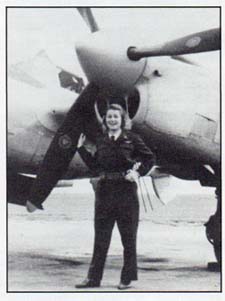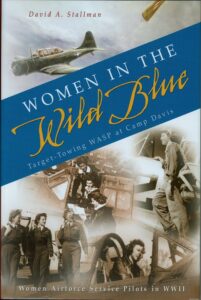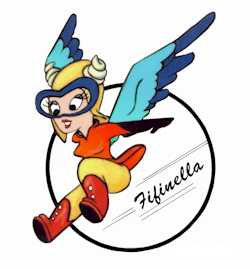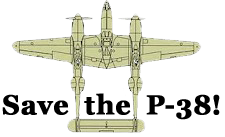Womens Airforce Service Pilots
(WASPs)
P-38 National Association
Visit the Museum
Visit the Store
Support Our Mission
“You have shown that you can fly wingtip to wingtip with your brothers. If ever there was doubt in anyone’s mind that women could become skilled pilots, the WASPs dispelled that doubt. I want to stress how valuable the whole WASP program has been for the country.”
Sweetwater, TX ♦ Dec 7, 1944
WASP Uniforms
One of the many challenges for these early pilots was finding uniforms to fit a non-male aviator!
When the order went out to the unenlightened Supply Corp to supply flight gear, they assumed (of course) that meant for men. The WASPs had great fun clowning around in those ill-fitting garments.
Uh…small problem!

Click Here to enlarge
Drawing by Dot Swain
from “We Were WASPs.“
Ferrying Also Had Tense Moments
(May 1988, Lightning Strikes)
Nancy Batson Crews delivered many P‑38s from California to the P.O.E. at Newark, NJ, but one trip left her less than ecstatic. Preparing to land at Pittsburgh, she saw that the nose wheel was not coming down. Although weary from the three-hour leg, she dutifully set to work with the manual pump.
“Ah lost track of the number of pumps,” recalls Alabama-born Crews, “But mah arm sure was sore.” Finally, when the nose wheel still would not budge, she used the C02 bottle . Ferry pilots had been instructed not to touch emergency equipment and WASPs assiduously obeyed instructions. But enough was enough.

So the landing was made, and the plane was inspected. After a day’s delay and the assurance that the problem had been fixed, Crews took off for Newark. As she approached , guess what? Same balky nose wheel. This time exasperated ferry pilot said the equivalent of “to‑H‑with‑it” and blew it down again.
That was one P‑38 which did not receive the customary friendly farewell pat.
Alabama’s First Lady of Flight”
 Nancy Batson Crews:
Nancy Batson Crews:
High school cheerleader, campus queen, pilot, wife, mother, politician and business woman!
 A tribute to the WASP, heroic young women who flew military aircraft, including P‑38s during WWII. The Women Airforce Service Pilots ferried aircraft from factory to airbase, and towed aerial targets for antiaircraft gunnery training.
A tribute to the WASP, heroic young women who flew military aircraft, including P‑38s during WWII. The Women Airforce Service Pilots ferried aircraft from factory to airbase, and towed aerial targets for antiaircraft gunnery training.
Origins of the
Women Airforce Service Pilots
Ferrying Division Air Transport Command
Up until three o’clock in the afternoon of May 29, 1941, there was no organization of any kind in American military aviation to provide for either the delivery of planes or air transport of material.
By the end of that day, the Air Corps Ferrying Command, which grew into the Air Transport Command with its major component the Ferrying Division, was in existence with an assigned military personnel of two. William H. Tunner, a Major, was one of the two. By June 1944 there were 50,000 personnel, 8,500 of which were pilots and the Major was a General.
“By the end of the war the Ferrying Division had delivered 21,092 foreign destinations and made 291,595 domestic ferrying movements.”
William H. Tunner (“Over the Hump“)
Enter the WASPs
By September 1941, the shortage of pilots was acute and licensed women pilots were selected for ferrying duty.
Although restricted to flights within the U. S., they satisfactorily crisscrossed the country in all directions to deliver various types of planes (i.e., primary, basic and advanced trainers, small tow-target planes and large cargo carriers).
Eventually over a thousand women were hired to fly military planes, with 303 in the Ferry Division. This dropped to less than 150 when the restrictions for women to remain in ferrying demanded qualification in fighter aircraft, because many preferred other duties such as target towing, instrument instructing, flight testing after repair and overhaul, etc.
Those remaining in the AFC ferried all types of fighters, bombers, drones, and transports to assigned destinations within the confines of North America. Besides the twin and four engine bombers such as the B‑25, A‑20, B‑26 and B‑17, these women ferried the single engine P‑39, P‑40, P‑47, P‑51 and P‑63 plus the twin engine pursuits, the P‑38 and the P‑61.
After completion of Pursuit School for the P‑39, P‑40, P‑47 and P‑51 the pilot returned to home base (Long Beach, Palm Springs, Dallas, Wilmington or Romulus). There the types of fighters to be delivered largely depended on geography. Although capable of flying any of the four, Wilmington pilots consistently flew P‑47’s from the nearby Republic factory, Romulus WASPs went to Bell for the P‑39’s and P‑63’s, and those from Dallas, Long Beach, and Palm Springs had P‑51’s to deliver, being close to either a modification center or the North American factory.
Orders for flying the various types of pursuits and bombers usually depended upon one’s base of operation. Those in the west near the Lockheed factory, considered themselves extremely fortunate to have access to the famous P‑38 “Lightning.” Some few of these pilots were able, because of seniority and luck, to ferry the Lockheed P‑38 and Northrop P‑61 Black Widow. Only twenty-three WASPs were so fortunate as to ferry the P‑38 to destinations in WWII.
38 WASPs Died while Serving our Country
In Memoriam
(Unfortunately, there is no sound and no names on these images)
WASP Artwork by Independent Artists
We ran across these cool pieces of art, which are a tribute to the WASPs. If you like them as much as we do, as of this publishing, it looks like you can order the artwork directly from the creators by clicking on their image or their title.
Lightning Lady
by Stan Vosburg
She may have come from a Kansas farm or a New York College. She was probably single and in her early 20s. She had dreamed of flying most of her life. The folks back home said she had “stars in her eyes and the sky on her mind.” We see her standing in the cockpit of a newly minted Lockheed P-38 Lightning. She was flying for the Women Airforce Service Pilots, or WASP of the Army Air Corps.
ORDER HERE
WASP Special delivery
by Gil Cohen
During the late Autumn of 1944 on the tarmac of the Lockheed Aircraft Plant in Burbank, California, a group of four Women’s Airforce Service Pilots (WASP) are gathered around their flight leader. She is kneeling and pointing to a significant rendezvous point on an aerial map, reinforcing the path of the WASP flight plan. Their mission is to ferry five P-38 Lightning fighters to a port of embarkation where the planes will be shipped to bases overseas.
ORDER HERE
The P-38 Association does not receive a commission from referring you to these artists. We just thought they were beautiful!
Most content in this section was compiled and donated by WASP Mary Lou Neale, now passed away. To read more about Mary Lou, click here.
Helpful WASP Links
Female WWII Pilots: The Original Fly Girls
(NPR Ausio Recording)
American Experience: Fly Girls
(DVD)
WASPs Awarded Congresssional
Gold Medals
Evelyn Genevieve Sharp

Evelyn Sharp (“Sharpie) was one of the original Women’s Auxiliary Ferrying Squadron (WAFS) pilots with over 3,000 flight hours logged when she joined. The WAFS (under Nancy Love) were soon merged with the Women’s Flying Training Detachment (under Jacqueline Cochran) to form the Women Airforce Service Pilots (WASPs).
Sharp was the only WASP to die in a P‑38. On April 3, 1944 in Cumberland County, PA, the Lightning she was ferrying lost an engine on takeoff and crashed.
She was 24 years old.
WASP Books
There are many, many great books written about these amazing heroines. To check out these WASP books and other fun WASP products have a look here on Amazon.
Jacqueline Cochran
“Five stars for Col. Cochran!”
Great Women in Aviation
#1 – Jackie Cochran
A WASP Among Eagles
A Woman Military Test Pilot in World War II
” Absolutely amazing autobiography!”
And plenty more where these came from on Amazon!
Important Notice
Although we are housed on the grounds of the March Air Museum, the P‑38 Association’s Museum is a separate and independent non-profit organization.
We are not affiliated with the USAF or Lockheed, and our entire operation is supported solely by people like you. See how you can help us with our mission!
Non-Profit StatusThe P-38 National Assn is a 501(c)(19) non-profit, tax–exempt veteran’s organization.








